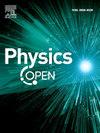First-principles calculations to investigate electronic, optical and thermo-elastic features of monoclinic AgCuO2 alloy
IF 1.4
Q2 Physics and Astronomy
引用次数: 0
Abstract
Structural, electronic, mechanical and optical properties of AgCuO2 have been unveiled through first principles calculations based on density functional theory (DFT) via CASTEP code. The evaluated lattice parameters agree with the previous theoretical and experimental observations for the monoclinic structure of AgCuO2. The electronic band structure and density of states (DOS) analysis at the Fermi level confirms the metallic behavior of AgCuO2. Besides, the partial density of states (PDOS) reveals that Cu-3d and O-2p orbitals are primarily responsible for the formation of metallic bands. Various optical properties have been calculated along different polarization directions, and the obtained results re-confirmed the metallic nature of AgCuO2. All the optical spectra exhibit anisotropic behavior, indicating potential applications in direction-dependent optical devices. The high reflectivity in the infrared and visible regions suggests that AgCuO2 can be potentially used in optical mirrors and thermal barrier coatings. Analysis of additional optical parameters indicates that AgCuO2 could be a promising candidate for optoelectronic devices. The calculated elastic tensor satisfies the stability criteria, confirming the stability of the monoclinic structure. The estimated elastic parameters suggest that AgCuO2 is soft, ductile and anisotropic. A mixed bonding character with dominating ionic contribution in the crystal system is established from elastic constant and Mulliken bond analysis. The calculated lower value of Debye temperature specifies that AgCuO2 is a soft material with lower lattice thermal conductivity. The weaker interatomic bonding properties due to lower Debye temperature, low melting temperature and minimum thermal conductivity make it a possible candidate for TCB material.
用第一性原理计算研究单斜AgCuO2合金的电子、光学和热弹性特性
通过CASTEP程序,基于密度泛函理论(DFT)的第一性原理计算,揭示了AgCuO2的结构、电子、机械和光学性质。计算得到的晶格参数与以往对AgCuO2单斜结构的理论和实验观测结果一致。费米能级的电子能带结构和态密度(DOS)分析证实了AgCuO2的金属行为。此外,偏态密度(PDOS)表明Cu-3d和O-2p轨道是金属能带形成的主要原因。沿不同偏振方向计算了各种光学性质,所得结果再次证实了AgCuO2的金属性质。所有光谱都表现出各向异性行为,表明在方向相关光学器件中的潜在应用。红外和可见光区的高反射率表明,AgCuO2可以潜在地用于光学反射镜和热障涂层。附加光学参数的分析表明,AgCuO2可能是光电子器件的有前途的候选者。计算得到的弹性张量满足稳定性判据,证实了单斜结构的稳定性。估算的弹性参数表明AgCuO2具有软质、延性和各向异性。通过弹性常数和Mulliken键分析,建立了晶体体系中以离子贡献为主的混合键特征。计算得到的Debye温度下限说明AgCuO2是一种晶格导热系数较低的软质材料。由于较低的德拜温度、较低的熔融温度和最小的导热系数,使其原子间键性能较弱,使其成为TCB材料的可能候选材料。
本文章由计算机程序翻译,如有差异,请以英文原文为准。
求助全文
约1分钟内获得全文
求助全文
来源期刊

Physics Open
Physics and Astronomy-Physics and Astronomy (all)
CiteScore
3.20
自引率
0.00%
发文量
19
审稿时长
9 weeks
 求助内容:
求助内容: 应助结果提醒方式:
应助结果提醒方式:


